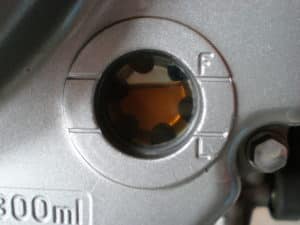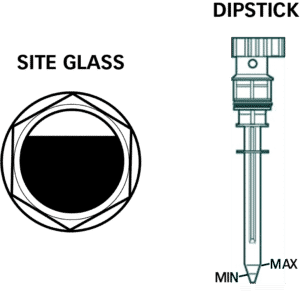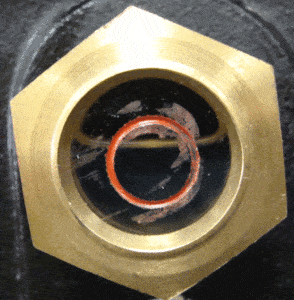New users often ask this question, “How to check an air compressor’s oil level?”
Although it is an easy task, a user should know how to read the air compressor oil levels to ensure the compressor doesn’t run out of oil due to leaking and also not flooded.
No matter what brand or model you have, I will show you how you can check the oil level of your own compressor. But before we proceed, I would like to tell you something about the importance of this task.
Table of Contents
How to Check Air Compressor Oil Level
Every air compressor that requires uses oil in its crankcase, has the facility to check the oil level provided with an air compressor oil level gauge. If you have got a direct drive compressor, you will find a dipstick on the oil cap in the crankcase. Some of the large air compressors have site glass that makes it easier to check the oil level.
Now whatever the specification is, you need to turn off the air compressor before you check the oil level. Why?
You have guessed it right. Due to the shaking and vibration, the oil is never at the rest and sometimes it may block your sight and make the whole dipstick covered with oil. And also for an air compressor with a dipstick, it will create a problem to open the oil cap as oil may come out from the crankcase and you shall face other troubles.
Checking Oil Level Through Site Glass
Site Glass Having a Circular Mark at the Center 
Most of the site glass has a circular mark at the center (generally red). In this case, the oil level should be in between the center of the circle and the upper edge of the circle. So –
- Higher Limit: Upper edge of the circular mark
- Lower Limit: Center of the Circular mark
Site Glass without any Mark

Again, you might have got a site glass without any marking on it. But don’t be afraid, I have got a solution for you.
In such a case, you have to ensure that the oil level is in between 2/3 and 1/3 (1/2 for some of the compressors. See the manual) of the vertical length/height of the sight glass. So –
- Higher Limit: 2/3 of the vertical length or height of the sight glass
- Lower Limit: 1/3 or 1/2 of the vertical length or height of the sight glass
Checking Oil Level by Dipstick

After you have turned off the compressor just open the oil cap and you will find the dipstick attached to it. Take it out and sweep the oil from its body with a towel or anything suitable but make sure that thing is clean. Normally, you will find two marks on the dipstick. The top one represents the upper limit and the bottom one represents the lower limit. Make sure the oil level is always in between them. So –
- Higher Limit: Top Mark on the Dipstick
- Lower Limit: Bottom Mark on the Dipstick
Why Checking Air Compressor Oil Level A MUST?
In every air compressor there are a number of moving parts and to prevent excessive friction among them, constant lubrication inside the crankcase is necessary. That is why we use oil in an air compressor. Oil also provides some degree of airtightness between the pistons and piston holes.
Now you might ask where the oil goes that we need to check it a refill it.
It is gradually lost through the exhaust and the air intake hole when you run the compressor.
It is recommended that you check your air compressor oil level each day before using it. Why?
If the compressor is ever out of oil and you keep it running, you are killing it for sure. So, to get an efficient outcome and extended life from your compressor, checking the oil level and feeding it with enough amount oil is an important maintenance task.
Overfilling the Compressor with Oil: What Are the Problems?
At the time of refilling or changing, if you have put more than your air compressor oil capacity, a number of problems can arise. The most common scenarios are –
- Seepage of oil in the discharge.
- Leakage of oil through other parts.
- Excess oil may burn and you might notice the smell.
- Oil can be deposited in the tank.
What to Do When There Is Too Much Oil in Air Compressor
When you have accidentally overfilled your compressor with oil, you can’t help but have to take it out. You got two solutions for you –
- Use a sponge to seep out the excess oil from the crankcase by inserting it through the oil cap. It will seep the oil by the capillary action.
- Use a siphon pipe to drain the excess oil. To do this, keep the compressor in a higher place than the floor. Insert one end of the siphon pipe into the crankcase and keep the other end low enough so that the oil can come out due to the gravity action.
Never Run Out of Oil In Your Compressor: Here Is How?
I have already told you that running an oil compressor without a proper oil level means killing it gradually. There is no way that you can attach a continuous supply of oil with your compressor as it’s not engineered in that way. The best you can do is to check the oil level once every day or several times a day if it is in a continuous operation. And if the usage is occasional, check the oil level before you turn it on.
Sometimes you may find your compressor consuming more oil. This indicates that something isn’t right with it. This may be because of the burning of oil in it due to excessive heat or seepage of oil in different ways. In such situations, you should look for a mechanic or consult the manufacturer.
So, to be safe from oil-related problems, the thumb rule is to maintain the exact oil level that the manufacturer recommends.
FAQ
When should I change my compressor oil?
Just after putting in action the oil gradually loses its properties and starts getting dirty. When its properties no longer meet the minimum requirement of your compressor, you should change it.
How often should you change the oil in your air compressor?
There is no exact result to these questions. Air compressor oil change interval varies from compressors to compressors. Like-
- For Rotary Screw Compressor after 7000-8000 hours of use if you use standard oil and every three months if you use food-grade oil.
- Reciprocating Compressor every 3 months.
- One a year no matter what compressor you are using.
What oil do you put in a compressor?
If the manufacturer doesn’t strictly recommend one use 20W ISO 68 or 30W ISO 100 non-detergent oil. You can also read our guide on buying the best air compressor oil.
Finally, I will advise you to make it a habit of checking the oil level of your compressor. This will help you to avoid any unwanted oil-related troubles by helping you to maintain a proper oil level.

Is buying a used compressor ok?
If it works and it’s cheap it’s fine
Far from comprehensive. No help for a compressor with no site glass or dip stick. Only option is visual through fill hole.
Yeah done that thxs
Hi I got a tiger air master compresser with out a dipstick do you no of anywhere I can get one try ebay Amazon and Google no joy there thxs